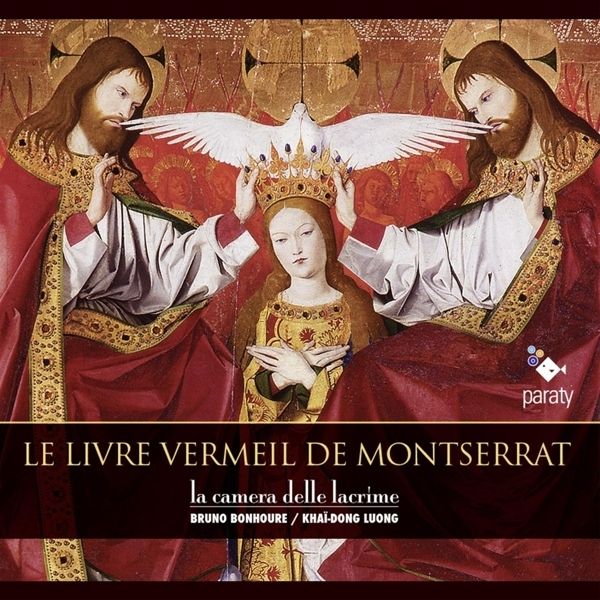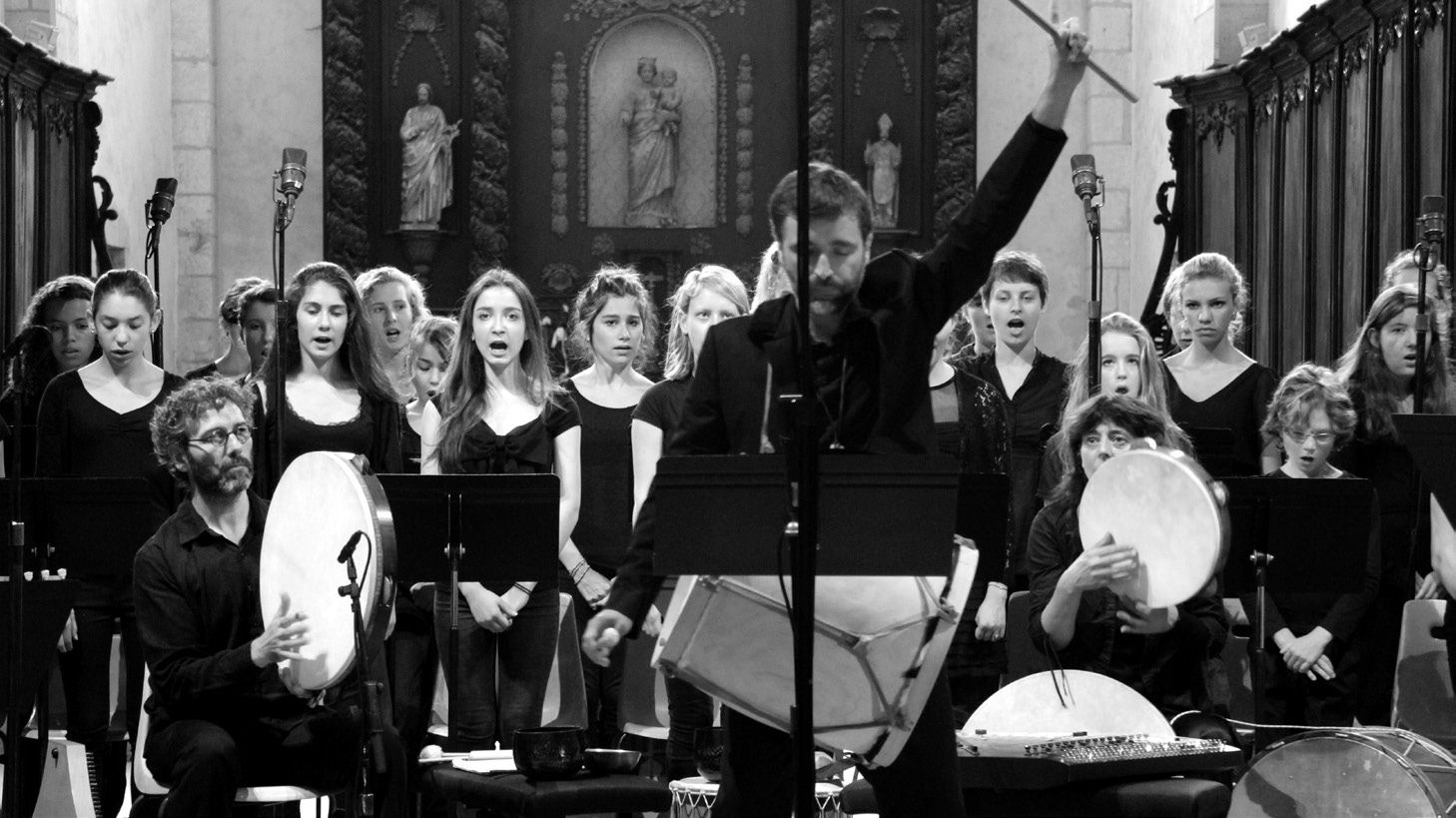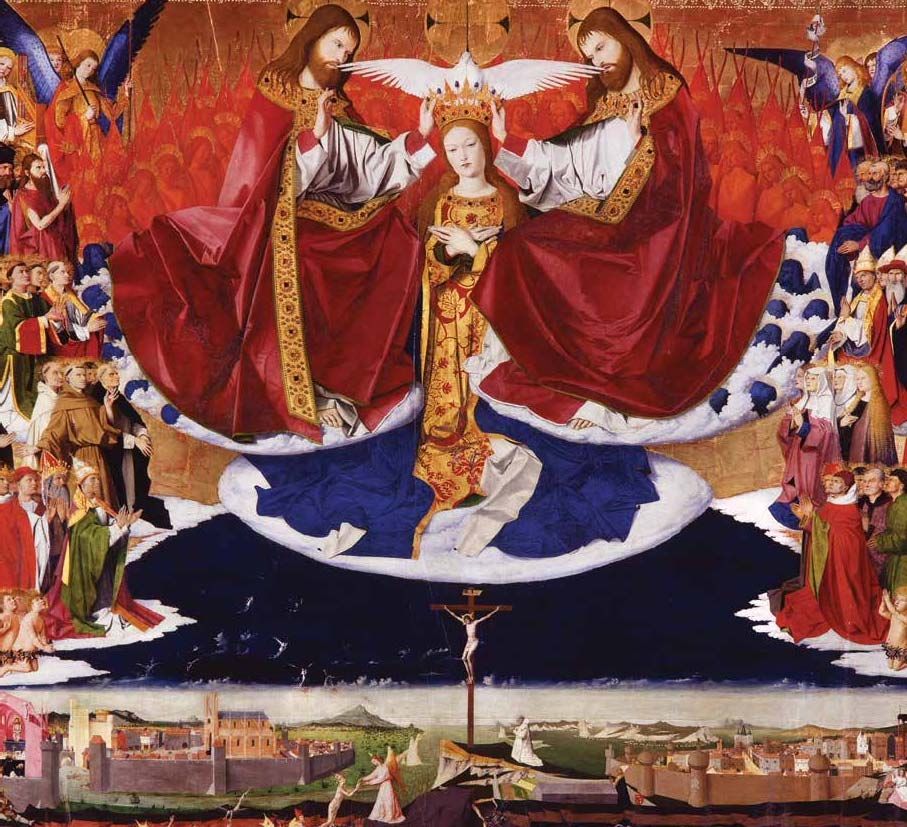Le Livre Vermeil de Montserrat
La Camera delle Lacrime

medieval.org
lacameradellelacrime.com
Paraty 414125
2014
1. Le chant de la Sibylle [7:03]
2. O Virgo splendens [3:39]
LV 1
3. Polorum regina [5:13]
LV 7
4. Cuncti simus concanentes [5:47]
LV 6
5. Imperayritz de la ciutat joyosa ~ Verges ses par [3:44]
LV 9
6. Stella splendens in monte [6:53]
LV 2
7. Los set goyts recomptarem [7:03]
LV 5
8. Mariam Matrem Virginem [4:00]
LV 8
9. Rosa plasent [3:33]
melody: Bruno Bonhure
10. Laudemus Virginem
LV 3 —
Splendens ceptigera
LV 4 [2:27]
11. Ad mortem festinamus [5:56]
LV 10
12. Els Segadors [5:57]

LA CAMERA DELLE LACRIME
Bruno Bonhoure & Khaï-dong Luong
Sarah Lefeuvre — Voix et flûtes à bec
Tiphaine Gauthier — Flûtes à bec
Michèle Claude — Percussions, tympanon
Stefano Genovese — Psaltérion, tambour sur cadre
Andreas Linos — Vièle à archet
Jean-Lou Descamps — Vièle à archet et tanbura
avec la participation du
Jeune choeur de Dordogne
Christine et Philippe Gourmont, direction
Captation réalisée par France Musique dans le cadre du
concert à Sinfonia en Périgord, le 28 août 2013
Production : Paraty
Directeur du label / Producer : Bruno Procopio
France Musique
Direction artistique / Artistic Direction and Editing : Daniel Zalay
Ingénieur du son / Balance Engineer : Laurent Fracchia
Assistants / Assistant Balance Engineer : Christophe Goudin et Xavier Lévèque
Création graphique / Graphic design : Leo Caldi
Photographe / Photography : Khaï-dong Luong
Traduction de l’occitan vers le français : Didier Perre
Traduction du français vers l’anglais : Ivan Ilic
Couverture
/ Cover : Enguerrand Quarton, « Le Couronnement de la Vierge »
(détail), 1453-1454 ;
Villeneuve-lès-Avignon, Musée Pierre-de-Luxembourg
(Photo du musée)
Remerciements :
Un grand merci à toutes les
personnes qui ont participé à l’élaboration de ce disque, nous pensons
bien sûr au collectif du Périgord, Christine et Philippe Courmont, David
Théodoridès, les enfants du Jeune choeur de Dordogne, mais nous
voudrions également associer à notre souvenir les chanteurs des autres
territoires qui étaient à nos cotés
pour louer l’énergie du pèlerin
sur les chemins du massif de Montserrat : “Les croissants d’or” de
Lorraine, “Castella” de Picardie, “Volubilis” des Pays de la Loire, “Le
Choeur du Centre de Musique Sacrée” et “Arpège 122” d’Auvergne, “Les
Boucles d’Oise” d’Ile-de-France sans oublier les collégiens d’Auvergne,
d’Alsace, d’Ile-de-France, de Poitou-Charentes, de Picardie et de
Haute-Normandie… et merci d’avance à tous ceux qui nous rejoindront par
la suite.
Une pensée à la mémoire de Roger Tellart, critique musical,
qui veilla toujours à écouter d’une oreille attentive et à donner son
sentiment éclairé sur les trois premiers disques de La Camera delle
Lacrime.
Paraty2014

Imagine
the pilgrim’s exaltation! The toils and travails of the road are erased
by the joy of having reached one’s goal. The desire to sing, to dance,
in a word: to exult. There is one place in the Iberian Peninsula where
such conspicuous enthusiasm is the rule. Almost as well-known as
Santiago de Compostela, on which converge all those in Europe who wish
to commune at the grave of St. James the Great, the Monastery of
Montserrat in Catalonia draws innumerable devotees anxious to visit the
Black Virgin on which rests the establishment’s renown. Legend has it
that in 880, a miraculous vision led local shepherds to a grotto where
they found an image of the Saviour’s mother, which proved impossible to
move to a more accessible location. So the site was itself consecrated: a
chapel was built to house the image, and a monastery soon followed. As
Christian fervour fed on the Reconquista, forever pushing further back
the Iberian pale ruled by Islam, new levels of devotion accrued to the
Virgin of Montserrat. The polychromatic wooden statue that can currently
be admired in the sanctuary dates back to the early 13th century, when
communing with the Catalan miracle was no longer a peril, but an
adventure.
None of which alters the fact that on arriving at the
sanctuary, the ever-growing number of pilgrims created a delicate
practical problem. As convents are not hostelries with the calling of
welcoming visitors, always excepting passing noblemen, most pilgrims had
to remain in the Abbey-Church, men and women commingled, waiting for
the moment when they would be able to approach the altar and praise the
Virgin, begging her or thanking her for her protection. To successfully
balance the needs of monastery, parish and pilgrim was a daunting
proposition. Thus, in order to ensure that services, time for
contemplation, and festive celebrations not be mutually exclusive, the
monks of Montserrat devised a means whereby the energy of the faithful,
who fully intended to sing and dance on reaching the end of their
spiritual quest, could be reoriented to Marian devotion: using popular
themes, rhythms and melodies, enlivened with easily-memorised canons,
responses or refrains that could be taken up in chorus, or even
choreographed. It was an unusual formula, whose originality is marked by
the fact that at the time, having these distinct purposes cohabit was,
if not condemned, then at least previously unimagined This new concept,
which endured over the centuries, eventually gave birth to a repertoire
where the layman’s art grew in complexity as it interacted with the
learned, where the rules of plainsong meet those of ars nova, where roundels, virelays, goliards and courtly songs form a bouquet as sumptuous as it is unexpected.
It
is thanks to a precious manuscript, the fruit of a compilation
completed at the very end of the 14th century and preserved in the Abbey
of Montserrat’s library, that we know of the monks’ design. Only 137 of
the original 172 folios have survived. Among the numerous liturgical or
administrative documents, there is a short songbook (f.21v-27)
comprising ten anonymous songs. A note placed between the first two
songs specifies its mission: to assist those pilgrims who wish to occupy
themselves with singing and dancing during their vigil in the church of
the Blessed Mary of Montserrat, as much as outdoors during the daytime (“Quia
interdum peregrini quando vigilant in ecclesia Beate Marie de Monte
Serrato volunt cantare et trepudiare, et etiam in platea de die”), on condition that the songs remain decent and pious (“nisi honestas ac devotas cantilenas cantare”) and that care is taken not to disturb those who are deep in prayer or in devout contemplation (“ne perturbent perseverantes in orationibus et devotis contemplationibus”). Not that simple.
Fashioned
for the meeting place that was Montserrat, uniformity is scarcely the
rule here, no more in the music itself (four monodies versus six 2-, 3-
or 4-voice polyphonies) that in its notation (the style introduced by
Philippe de Vitry around 1315-1320 rubs shoulders with the square notes
of Gregorian parchments), nor in language, with liturgical Latin (eight
songs) competing with the local Catalonian, so closely related to
Occitan (two); nor in the choreographic options, with four songs being
accompanied by rounds (ball redon in Catalan), circle dances
where the dancers join hands. The whole assumes its own heterogeneity,
from its most ancient borrowings to its most modern biases, even when
the latter are wrapped in a “quaint” old style. A heterogeneity akin to
that of the pilgrims themselves, men and women from every land and every
background jumbled together in fraternal unity – the same unity that
gathers them, no longer smiling, in those Dances of Death that were
spreading over church walls as these songs were compiled, deriding human
vanity..
Across the centuries, the songs and dances that echoed
in the Abbey-Church of Montserrat retain all the flavour of their
uniqueness.
We cannot gauge the gap between these outbursts of
popular music and the plainsong tradition fostered by the monks of
Montserrat, as fires greatly depleted the treasures held in the library
of this holy place, to say nothing of the sacking of the monastery by
Napoleonic troops during the 1811 campaign. Luckily, the 1399 manuscript
was not currently there, having been loaned out for study to an erudite
Barcelonian. Who piously kept it. When, half a century later, his
descendants restored it to Montserrat, the monks clothed it in a cover
of wood and red velvet, earning it its contemporary name of Llibre Vermell de Montserrat.
By the latter part of the 19th century, the compendium had acquired so
great a renown that it was catalogued as the very first volume of the
new monastic library that its return symbolically re-established.
And
it is under this name, which might have been plucked from one of
Chrétien de Troyes’s romances, that this incredible document is now
known. A worthy salute to the legendary imaginings it illustrate.
Philippe-Jean Catinchi, Medieval historian

The Pilgrimage to the Moreneta: Joy and Exaltation
Nigra sum sed formosa…
The Llibre Vermell is a sort of practical manual for a well-conducted pilgrimage to the Moreneta:
it comprises religious poems, miracle tales, a calendar, a treatise on
confession, etc. It is famous because it includes the notation (words
and music) of nine pilgrimage songs. In truth, the manuscript contains
canticles that had no doubt already been popularised among the pilgrims
of Montserrat; the canticles are clearly by different authors in a
variety of styles.
One element of this diversity lies in the use
of language: two of the songs are in Occitan, one in Catalan – in the
Middle Ages the two languages were twins – and the others in Latin.
Their musical styles are likewise varied. Only two of the songs, Maria matrem and Impeyratriz de la ciutat joyosa are linked with the Ars Nova polyphonic style. The others are in a popular style, some of them including a refrain. One may note the Gregorian effect of O virgo splendens, Laudemus viginem and Splendens ceptigera.
The words of a tenth song, Rosa plasent, have been preserved thanks to a copy; Bruno Bonhoure has composed a melody for it.
All
authors have noted the stylistic heterogeneity of these songs, whose
only commonality is their aim of guiding pilgrims spiritually and
vocally, helping them avoid dishonest activities, as the text that
introduces Stella splendens in the codex demonstrates:
“When
they keep vigil in the church of the Holy Virgin of Montserrat,
pilgrims sometimes wish to sing and dance, likewise in daytime on the
church square. In this place, they must sing only honest and pious
songs; this is why some such are noted above and below. They must be
made honestly and with discretion, so as to not disturb those who pray
and are in contemplation.”
Thus the majority of the songs
whose melodies have been preserved are, if not popular, as least to
popular taste. Indeed, the guiding spirit of these medieval pilgrimages
was that of holiday, closer to popular fairs than to mystical
exaltation. Beyond the faith that was the pilgrims’ common culture:
these songs express the joy of being together and good cheer for the
road that has been travelled…
With the Dordogne Youth Choir,
Bruno Bonhoure and Khaï-dong Luong have preserved the responsorial
spirit of the songs with refrains, which is explicit in the manuscript
of Los set goyts, which specifies: ceteri respondeant (let all respond). Another responsorial hypothesis is proposed in Polorum regina between soloist, choir and instruments.
Stella splendens
is typical of songs in which an easily-remembered refrain replies to
narrative couplets intoned by the cantor. The latter joyously describe
the variegated crowd that comes to worship the Moreneta.
Only Ad mortem festinamus
does not invoke the Virgin, but rather reminds mortals of their
condition. The ensemble La Camera delle Lacrime proposes an
interpretation that evokes the ambience of the Dances of Death that
began to decorate sanctuary walls at the end of the 14th century.
It would be a betrayal of the Llibre Vermell’s
songs to mask the fact that they were, and have remained, a strong
element of Catalan identity. As though to emphasise this aspect the
recording opens with the Catalan version of the 13th-century Song of the Sibyl,
a song included in the Christmas liturgy. It describes the apocalyptic
prophecy of the Erythraean Sibyl, whose prophecy was set down by
Eusebius of Caesarea (around 265-339) and later transmitted by St.
Augustine.
Continuing in this vein of Catalan identity, the recording ends with the ancient version of the popular song Els segadors,
a lament recalling the Catalans’ revolt on 7th June 1640 against the
Castilian troops they were forced to feed and house. A modernised
version of this song, which was forbidden under Franco’s dictatorship
due to its use as a rallying song for the Republican partisans during
the civil war, became the national anthem of Catalonia in 1993.
Didier Perre
Councillor for the Langue d’oc
Le Puy-en-Velay, March 2014
La Camera delle Lacrime
Grouped
together around founding members Bruno Bonhoure and Khaï-dong Luong,
who created the ensemble in 2004, the musicians and artists of La Camera
delle Lacrime are committed to rediscovering and showcasing a
historical musical heritage while renewing it through their creative and
interpretative choices.
With the assistance of specialists and
scholars, La Camera delle Lacrime offers performances of music from the
past that dramatize the repertoire, making it more intelligible and
accessible.
The ensemble’s name pays homage to Dante Alighieri,
poet and friend to troubadours. Dante spoke of this ‘Chamber of Tears’
as a place where he would overcome distress and return to his roots,
re-emerging with newfound energy.
Bruno Bonhoure, musical director, solo voice, bombo legüero
Born
in 1971 in Aurillac, Bruno Bonhoure carries with him the heritage of
songs and tales that punctuated the peasants’ daily life in the Haute
Auvergne. Dedicating himself first to art history, his need for and love
of the stage led him to Paris.
Compared to the ‘Bildung’ (a
person who makes himself valuable by virtue of his own efforts) by Carlo
Ossola (Professor at the Collège de France) and to Giovanna Marini by
Lionel Esparza (Radio France), the quality of Bruno Bonhoure’s voice,
his stage presence and his personality make him one of the most
captivating French tenors on stage today.
As the ensemble’s
musical director, Bonhoure promotes the Occitan language through
multidisciplinary shows. His projects have offered a new interpretation
of the historical musical repertoire in Occitan and have been praised by
the Languedoc Academy of Arts, Letters and Sciences.
Khaï-dong Luong, staging, scenography, artistic co-producer
Born in Cambodia in 1971, Khaï-dong Luong arrived in France after fleeing the Khmer Rouge. With a degree from the Agrégation des mathématiques
and a Masters in Film Studies, his main focus is the creation of
alternatives to pre-established styles. Luong surprises and innovates by
restructuring habitual formats and brushing aside convention. He has a
contemporary vision of how to interpret historical repertoire which has
led him to consider new methods of communication; examples include the
participation of local singers in a show based around the Red Book of
Montserrat (the Llibre Vermell).
A multifaceted artist,
while in Chicago he co-wrote the documentary Someplace Else, which was
selected by the Los Angeles, New York and Chicago Film Festivals, as
well as a series of animated films selected by the Annecy Festival.
The Dordogne Youth Choir, Directed by Christine and Philippe Courmont
The Dordogne Regional Conservatory
The Périgueux Conservatory of Music and Dance
Created
in the year 2000 under the aegis of the Dordogne Regional Conservatory
and the Périgueux Conservatory of Music and Dance, the Dordogne Youth
Choir offers full vocal training to children and teenagers. With regular
concerts in Aquitaine, the Dordogne Youth Choir regroups some 35-40
youngsters in Grades 4-12 from Bergerac, Périgueux and Ribérac.
Christine
and Philippe Courmont have been particularly influenced by the
remarkable work of the Finnish Tapiola Children’s Choir and of the Radio
France Choral School, from whom they have retained essential
pedagogical principles that foster their work in Dordogne: constant
attention to the quality of vocal work, focus on the group’s musical
listening skills, promoting and respecting children’s voices, searching
for the young singers’ autonomy, a ‘collegial’ apprenticeship where the
teenagers participate in initiating the younger singers, the importance
given to staging and the singers’ bodily involvement. Encounters with
other conductors and other choirs, along with links to other disciplines
(dance, theatre…) further promote this artistic project’s quest for
open-mindedness.
The Dordogne Regional Conservatory is supported by the Ministry of Culture and the General Council of
Dordogne. The Périgueux Conservatory of Music and Dance is supported by the Commune of Périgueux.
The Sinfonia en Périgord Festival
was created in 1990. Dedicated to period instrument performance, the
festival is a joyful exploration of Early Music. The festival welcomes
the most innovative ensembles in late August of each year in the heart
of beautiful Périgueux.
The entire Sinfonia en Périgord team is
delighted to have supported the Livre Vermeil project alongside La
Camera delle Lacrime. The “Culture Loisir Animation Périgueux”
Association, which manages the Sinfonia en Périgord Festival, is a
longstanding partner of La Camera delle Lacrime, and strongly
contributed to making this musical adventure possible.
The Sinfonia en Périgord is supported by the Aquitaine Regional Directorate of Cultural Affairs (DRAC),
the Aquitaine Regional Council, the Dordogne General Council, and the cities of Perigueux, Chancelade and
Coulounieix-Chamiers. The festival is a member of the Federation of French Festivals.



